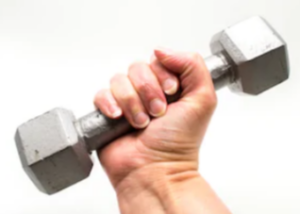
Do you keep performing “strength tests” because you think you might have wrist drop and therefore a neurological disease?
Repeatedly doing these tests with no end in sight will cause you tremendous anxiety.
Are you finding that even though the latest strength test seems to be reassuring, it’s never good enough – and it won’t be long before you’re craving another “fix”?
As a former personal trainer, I’ve come up with some sure-fire strength tests for those who are worried they might have wrist drop.
The main test involves the action of wrist extension against resistance: the opposite of wrist drop.
What You Need
One dumbbell – anywhere from three to five pounds. A similar-weight kettlebell will also do.
Picking up objects around the house can lead to temporary feelings of reassurance, but the wrist exercises you can do with a dumbbell will provide more objective feedback in a more structured way.
How to Do the Exercises
Wrist Extension. You’ll be doing this with both hands, one at a time. This way you can have a reference point for the wrist that you think is dropping. You’ll be doing your first set with the wrist for which you suspect weakness.
While supporting your arm on a leg/knee, hold the dumbbell with palm facing the floor, wrist relaxed so that it’s naturally bent.

BrusBlaus, CC
Next, extend or lift the wrist so that your hand goes above parallel. You don’t need to hold this position; just achieve it, then lower to the starting point. That was one repetition.

BrusBlaus, CC
Repeat this until your forearm and wrist fatigue – but count the number of repetitions this takes.
Now repeat with the “good” wrist, counting the number of reps it takes to reach fatigue.
Do NOT panic if the number of reps for the “good” wrist exceeds the number for the one that you fear has a drop.
A slight disparity may be psychological, in that you might subconsciously work the good wrist harder, tolerating more fatigue and burn.
Another reason for a slight disparity is that the wrist that you suspect has a drop might be your non-dominant hand.
But what if the wrist drop side IS your dominant hand and it took fewer reps to reach fatigue?
Either you subconsciously pushed the good wrist more, as a way to prove your suspicion (which sounds odd, but the mind can play this trick on you), OR…your non-dominant side is used more in a way that gives it more endurance for this exercise.
So even though you don’t write or use a mouse with your non-dominant hand, could it be possible that you DO use it more in other ways that would explain why it didn’t fatigue as quickly for the exercise?
For instance, a person may pick up plates at the gym more with their non-dominant hand in an attempt to keep things even. This can lead to a stronger non-dominant side.
With that all said, there shouldn’t be more than a slight difference in the number of reps for each hand.
If there was, then repeat the exercise – after both sides have recovered and no longer feel achy or burning.
If the exercise was difficult for both sides, the weight was too heavy.
Wrist Flexion. Repeat the exercise except this time, reverse the hand position. You can also use a short bar if you don’t have access to a dumbbell or kettlebell.

Hipnotic88, CC BY-SA
Keep in mind that wrist extension is the better test for a drop. But the more wrist related exercises you can perform equally to the good side, the more reassured you’ll be.
This brings me to the next exercise.
Hand Grip. Count the number of times you can squeeze the handles of a hand grip device all the way together.

Freepik.com
Or, count the number of seconds you can maintain a single squeeze. Then compare to the other hand.
These tests are objective and will be far more telling of your wrist strength than will be randomly picking up objects around the house.
“Radial nerve, which is a branch of the nerves coming out of a brachial plexus, is responsible for wrist extension,” says Natasha Fuksina, MD, an internal and integrative medicine specialist who combines traditional, integrative and functional medicine to restore health and function.
“Various conditions which weaken or injure the radial nerve can cause wrist drop.
“For example, prolonged use of crutches can damage the radial nerve and cause wrist drop.
“Injury or a stab wound around the clavicle [collarbone] can also injure the radial nerve.”
What an Actual Wrist Drop Looks Like
The photo below shows a wrist drop from an injury to the radial nerve.

St Bartholomew’s Hospital Archives & Museum, Wellcome Images. [1883-1884] By: Godart, ThomasSt Bartholomew’s Hospital Archives & Museum
 Dr. Fuksina is the founder of astraMDhealth, which includes telemedicine. Double board certified in internal and obesity medicine, she focuses on a personalized approach, including metabolism and genetic makeup, to customize treatments and preventive care.
Dr. Fuksina is the founder of astraMDhealth, which includes telemedicine. Double board certified in internal and obesity medicine, she focuses on a personalized approach, including metabolism and genetic makeup, to customize treatments and preventive care.
 Lorra Garrick is a former personal trainer certified through the American Council on Exercise. At Bally Total Fitness she trained women and men of all ages for fat loss, muscle building, fitness and improved health.
Lorra Garrick is a former personal trainer certified through the American Council on Exercise. At Bally Total Fitness she trained women and men of all ages for fat loss, muscle building, fitness and improved health.
.









































